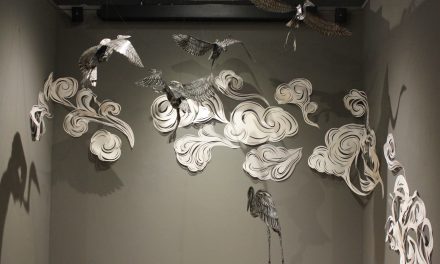As a child, David Ellsworth was always the “maker” who charmed and delighted playmates by producing typical Baby Boomer toys: bows and arrows, rifles, pistols, swords, tomahawks, and blowguns – all fashioned from wood and leather.
“It was the 1950s, so life revolved around cowboys and Indians,” explains Ellsworth, who has since graduated to elite woodworker status with a name that universally involves respect among fellow artisans.
He was fortunate that his moment of woodworking epiphany came early, when he accompanied his father to a cabinet shop and breathed in the tantalizing aroma of sugar maple going through a table saw. “I was hooked,” he recalls. “I made my first turning – a 24-inch-diameter platter – in my eighth grade shop class. That was 1958. And I continued throughout my high school years.”
Still, his personal path to artistic success was hardly direct and uncomplicated. After growing up in the mountains of Colorado, Ellsworth spent three years in the United States Army in the early to mid 1960s before deciding to study architecture at Washington University in St. Louis. “Flunked out in three semesters before going to New York to become an artist,” he says.
It was at Washington University that he met architecture design professor Lesley Laskey, who essentially told him to “get out of architecture and go into the fine arts, where I belonged. That’s what prompted the trip to New York,” Ellsworth recollects. There, he studied at the New School for Social Research until 1970 before moving back to Boulder, Colorado, to finish up his undergraduate degree, and then stay on to complete his Master of Fine Arts degree in sculpture and drawing.
He returned to woodturning in 1973 after graduation and felt “as if I’d never left the lathe.” But it was through his work with ceramics that he realized the impact the vessel form had on him. “In particular, I was moved by the designs of Native American potters, and, most notably, the Sikyatki Hopi potter, Nampeyo,” he says.
After struggling to land his first job, he says he was eventually hired by a ceramist, the late Paul Soldner, to start a wood program at the Anderson Ranch Arts Center in Snowmass Village in 1974. “Paul’s influence was primary in my life,” says Ellsworth, who also cites Peter Volkous, the late abstract expressionist ceramic artist who elevated traditional ceramic crafts into fine art, as a strong influence. “Paul helped me to understand the inter-dependence of art and craft, and how one could build a life based on skill, dreams, high energy, and hard work.”
Ellsworth worked there one year before deciding to strike out on his own and open his own studio in Boulder. “I did some turning production work, shot pool for some extra income, and developed a series of bent turning tools so I could hollow out a solid wooden form on the lathe,” he says.
During that period, Ellsworth said he was divorced, and “living and working in a 16-foot square room with nothing to do but turn wood. Eighteen-hour days were the norm.”
Armed with ample inventory, he went to his first national craft show – the Pacific States Show in San Francisco – in 1977, where he debuted to rave reviews. “When I went national with my work, I received universal acceptance from craft galleries and makers in all media, which is something that I never expected,” he says. “It was like instant validation.” A second show in Rhinebeck, New York, followed in 1978, and his profile within the industry rose further when he penned an article on his process for hollow turning for Fine Woodworking magazine a year later.
At that point, he realized that it was time to get back to work in earnest. He moved into an old family cabin in the mountains and “dug in for the winters,” he says. “I emerged in the summers to do national craft shows,” Ellsworth continues. “My work was constantly evolving and maturing, and I would always come to the shows with objects that were more challenging, more exploratory, and more vibrant.”
As his work blossomed, so did the sales, however sporadic. “It paid the bills…mostly,” he says. “But money was never my motivation. It was the process itself, this centering process – like throwing pots on a wheel – that drew me in and held me throughout the working life of each object.”
Ultimately, Ellsworth said he left craft shows in 1985 so “I could get into the better-quality galleries I had been seeking from the beginning. I’ve been terminally unemployable ever since.” Ellsworth’s modesty is somewhat misplaced. His highly acclaimed work can be obtained in galleries, auctions, and through private sales.
“But I think that people who just stumble onto my work are often quite taken aback, and they tend to search for a reference to define it,” he says. “It’s easier today with so many people doing hollow forms, but my work isn’t flashy, so it can take time to appreciate its subtleties and inner power.”
He wryly describes himself as “a wooden potter. The work is very clay-esque, earthy, not unlike myself, and that surely takes a bit of time to digest.”
Ellsworth recalled a period in the late 1980s, when he introduced his “Solstice Series” of pieces that weren’t easily categorized as typical vessels or bowls. “They were really more sculptural forms that were turned, and then burned, and then painted,” he says. “My more forgiving friends loved them, but many people absolutely hated them. And I was thrilled! I knew I’d crossed a very important threshold in my career.”
As with most successful artists, Ellsworth is motivated to continue to evolve, testing his own creative boundaries, as well as those of a discriminating public. He seeks, and finds, constant inspiration from “the growing number of young and exciting artists/turners who make up this field of woodturning and the imperfections of people, materials, and the process that I use to make what I make.”
He remains active in the American Association of Woodworkers, which he founded along with eight other members of the original board. “As the first member of the organization, its first president, and the first chairperson of the Professional Outreach Program committee, I suspect they continue to have a hard time getting rid of me,” he says.
He also, he says, simply remains “open and aware of my surroundings, my materials, and whatever directions the making process might take me. I try to retain a constant connection with the value of change, for it’s through that change that we evolve naturally within the creative process.”
Ellsworth offers the following advice for those who aspire to duplicate his creative and business success:
1 Trust your instincts to know that you’re on the right path, and to recognize when it is time to take your work to the next level – even when that means holding on through a period of economic discomfort. “As a career direction, the crafted arts have never been considered to be a ‘safe place.’ Yet, it does provide the ultimate in self-expression and personal freedom,” he says. “All of us makers have struggled to develop ways to preserve our independence and to excel creatively within our chosen media. And it is this energy that drives the arts and crafts and helps to sustain the high levels of work we see today.”
2 Get out of your own backyard, and let your imagination reach into the unknown. “Makers like myself survive through the connection between our eyes and our hands. Whether it is making or marketing our artwork, it seems important to constantly reach beyond our own experiences. Otherwise, we risk becoming too satisfied with what we have already done.”
3 Study, and become a student of your craft. Examine the work of artists you admire. “Take drawing classes with live models, and balance your artistic training with classes in Tai Chi to keep you grounded as an artist and as an individual.”
4 Commit to the craft show circuit for at least five years to gain a full understanding of its value to you and your artwork. The shows also help build a resume, he says, and allow an artisan to pare down market venues as his or her work and knowledge of the marketplace grows. “Buyers respond to marketing consistency as a means of developing confidence in purchasing objects they like. And while it is never easy to consistently be juried into the same shows every year, it is important to keep your work visible whenever possible. Don’t become discouraged if you don’t get into a show. Keep applying every year, and to as many shows as you feel you can manage with your work. Visibility is a critical element in one’s marketing success.”
5 Learn to take good digital images of your work. “You really can’t survive without them,” says Ellsworth. “Good photography has always been the final step in transporting the objects we make to someone else’s living room. But marketing aside, good photographs provide a wonderful means of sticking our egos in our back pocket and ‘seeing’ our work with an objective eye: the camera doesn’t lie. Digital images also provide a historical record of our growth in design developments and personal aesthetics.”
6 Never let a finished piece into the marketplace until you are 100 percent confident of its quality. “The quality of your work is a measure of personal integrity,” he says. “A piece of questionable quality will come back to haunt you.”
7 Avoid copying other people’s designs like the plague. “Creative people have always been keenly aware of their inspirations. We need and use these inspirations as an aid in our search for a personal voice in the development of our artwork. But copying another person’s ideas for personal gain is a sign of inexperience and immaturity. The plagiarist not only hurts the plagiarist, they also hurt the entire field of the arts and crafts.”





